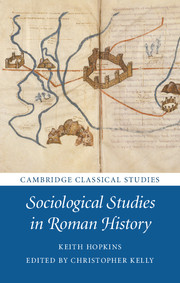Book contents
- Sociological Studies in Roman History
- Cambridge Classical Studies
- Sociological Studies in Roman History
- Copyright page
- Contents
- Figures
- Tables
- Contributors
- Preface
- Editorial Note
- Biographical Note
- Introduction Keith Hopkins: Sighting Shots
- 1 Contraception in the Roman Empire*
- 2 A Textual Emendation in a Fragment of Musonius Rufus: A Note on Contraception*
- 3 On the Probable Age Structure of the Roman Population*
- 4 Graveyards for Historians*
- 5 Economic Growth and Towns in Classical Antiquity*
- 6 Taxes and Trade in the Roman Empire (200 bc–ad 400)*
- 7 Models, Ships and Staples*
- 8 From Violence to Blessing: Symbols and Rituals in ancient Rome*
- 9 Slavery in Classical Antiquity*
- 10 Conquest by Book*
- 11 Novel Evidence for Roman Slavery*
- 12 Christian Number and its implications*
- 13 The Political Economy of the Roman Empire*
- 14 How to Be a Roman Emperor: An Autobiography*
- Original Publication Details
- Bibliography
- Index
- References
Bibliography
Published online by Cambridge University Press: 20 October 2017
- Sociological Studies in Roman History
- Cambridge Classical Studies
- Sociological Studies in Roman History
- Copyright page
- Contents
- Figures
- Tables
- Contributors
- Preface
- Editorial Note
- Biographical Note
- Introduction Keith Hopkins: Sighting Shots
- 1 Contraception in the Roman Empire*
- 2 A Textual Emendation in a Fragment of Musonius Rufus: A Note on Contraception*
- 3 On the Probable Age Structure of the Roman Population*
- 4 Graveyards for Historians*
- 5 Economic Growth and Towns in Classical Antiquity*
- 6 Taxes and Trade in the Roman Empire (200 bc–ad 400)*
- 7 Models, Ships and Staples*
- 8 From Violence to Blessing: Symbols and Rituals in ancient Rome*
- 9 Slavery in Classical Antiquity*
- 10 Conquest by Book*
- 11 Novel Evidence for Roman Slavery*
- 12 Christian Number and its implications*
- 13 The Political Economy of the Roman Empire*
- 14 How to Be a Roman Emperor: An Autobiography*
- Original Publication Details
- Bibliography
- Index
- References
- Type
- Chapter
- Information
- Sociological Studies in Roman History , pp. 556 - 557Publisher: Cambridge University PressPrint publication year: 2017



